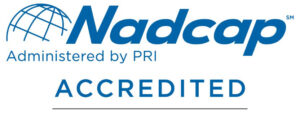Electroless Nickel
About Electroless Nickel
Electroless Nickel is an auto-catalytic plating process that deposits a uniform Nickel Phosphorus layer with significant advantages over traditional electrolytic nickel coatings. The absence of coating thickness complications that are created by current density provides a nickel deposit that is extremely uniform in coverage and thickness. This unique characteristic makes the Electroless Nickel (EN) process ideal for plating engineered components that are complex in shape and require tight “after plating” tolerances.
There are various types of Electroless Nickel coatings and processes available to meet different applications, conditions and requirements. Physical and mechanical properties of the coating such as hardness, corrosion resistance, and solderability vary from one EN process to another depending on deposit Phosphorus content, bath formulation and post plate treatments.
Contact the Electroless Nickel experts at Coating Technologies to determine which Electroless Nickel coating would work best for your application.
Electroless Nickel Process Specifications
- AMS 2404
- MIL-C-26074
- AMS-C-26074
- ASTM B733
- GPS 3108-1
- M695215
- HP4-10
All Electroless Nickel coatings are RoHS compliant.
Why Use Electroless Nickel?
The beauty of electroless nickel is that it plates evenly regardless of the complexity of the surface geometry of the part it is coating. Our clients are able to engineer the surfaces of their parts without regard to post plate grinding. Electroless nickel thickness is controllable to a very high tolerance.
The Benefits of Electroless Nickel PTFE:
- Electroless Nickel plating is extremely corrosion resistant.
- It provides superior adhesion to the substrate.
- It can be heat treated to make it harder in certain applications.
- Electroless Nickel is excellent at “part rescuing”. A part that does not quite meet minimum tolerances can be built to tolerance using Electroless Nickel.
- Electroless Nickel can be plated on a multitude of different substrates. For example: chrome moly, stainless steel, aluminum, brass, copper, high alloy aerospace metals.
- Electroless Nickel can be chemically stripped and replaced without any degradation of the substrate.
- It has anti-galling properties.
- It is easy to maintain and clean.
Medium phosphorus electroless nickel
Medium phosphorus electorless nickel is cost effective, corrosion resistant, and has excellent adhesion.
High Phosphorus Electroless Nickel
High Phosphorus electroless nickel is more expensive because of the additional plating time. It offers increased corrosion resistance and hardness.
CTL’s history with Electroless Nickel
Coating technologies started using Electroless Nickel in 1980, specifically for firearm applications. The advent of the Electroless Nickel PTFE was the genesis of Coating Technologies and our work in the aerospace industry. Since then we have been coating parts with Electroless Nickel plating for projects such as aircraft, missiles, engine and rocket parts, torpedo parts, and many commercial applications.
Coating Technologies offers both Mid and High Phosphorus Electroless Nickel
Mid Phosphorus
- 7-9% Phosphorus Content
- Moderate Corrosion Resistance
- RoHS Compliant
- HRC- 48-52 as Plated
- HRC- 64-68 with Bake
- 65 mΩ/cm Electrical Resistance
- Mixed Crystalline / Amorphous
- .05 W/CM*K Thermal Conductivity
- 1000ºC Melting Point
- .38 Friction Coefficient
- 1 G/cm³ Density
- 7% Ductility
- Magnetic
- Solderable
- Uniform
- Semi-Bright / Bright
High Phosphorus
- 10-12% Phosphorus Content
- Excellent Corrosion Resistance
- RoHS Compliant
- HRC- 41-46 as plated
- HRC- 63-67 with Bake
- 100 mΩ/cm Electrical Resistance
- Amorphous
- .08 W/CM*K Thermal Conductivity
- 880ºC Melting Point
- .45 Friction Coefficient
- 8 G/cm³ Density
- 50% Ductility
- Non-Magnetic
- Non-Solderable
- Uniform
- Semi-Bright / Bright
Additional Services
- Masking
- Abrasive blasting, sand or glass
- Pre-plate Stress Relief and Hydrogen Embrittlement Baking
- Expediting
- Aluminum Oxide
- Glass Bead

